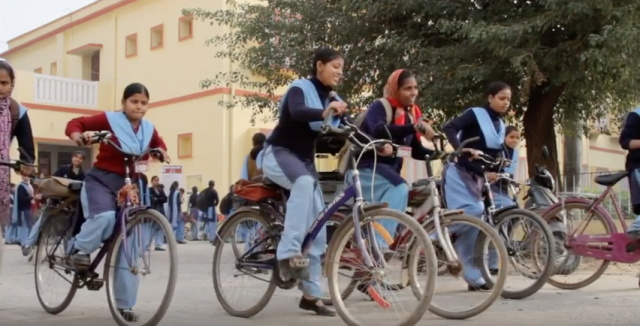This post by Meagan Neal, Abdul Latif Jameel Poverty Action Lab (J-PAL), is the second post in a blog series on overcoming barriers to girls’ education, based on J-PAL’s new synthesis of the evidence on improving student enrollment and attendance. Read the first post summarizing these barriers here.
In 2007, Afghanistan’s rural province of Ghor faced low primary school enrollment and a dramatic gender gap: Only 35 percent of boys and 18 percent of girls were attending school. School was also far away for most children—an average distance of three miles.
To help address the problem, the Afghan government and donor countries prioritized the creation of new schools. That included “village-based schools,” where instead of physically building a new school, communities provided space for a school in an existing building and an international NGO provided educational materials and training for teachers.
Embed from Getty Imageswindow.gie=window.gie||function(c){(gie.q=gie.q||[]).push(c)};gie(function(){gie.widgets.load({id:’hq5IqvZBRuZHFrmIqgMn6g’,sig:’Kz8e6DtABmyWLW4daw7xZPSKI4e0xYhulWt5DxW3z7o=’,w:’506px’,h:’336px’,items:’102522829′,caption: true ,tld:’com’,is360: false })});
Meanwhile, two researchers set out to test a simple question through a randomized evaluation of the village-based school program: Could improving access to school actually increase enrollment?
On the surface, that might seem a simple question—but it’s not always straightforward to identify the main barrier keeping girls out of school.
But first… is access the real issue?
Living in a remote area usually means that a child must make a long journey—twice a day, every day, and typically on foot—in order to attend school. This journey carries a substantial cost.
For many, traveling to school consumes valuable time that could be spent helping with chores or earning wages. Girls in particular may face community disapproval, get catcalled, or be at serious risk of violence.
But while reducing the distance to school might make it easier to attend, other factors could also be at play: If parents hold conservative beliefs about girls’ role in the household or have a low regard for education in general, making school more convenient is unlikely to have a meaningful impact on girls’ enrollment. Early marriage, household responsibilities, lack of job opportunities, and lower wages for women could all discourage parents from making investments in girls’ education.
So did village schools in Afghanistan make a difference for girls?
What we learned
Researchers found that introducing village-based schools in Afghanistan increased enrollment from 27 to 69 percentage points! The program also closed the gender gap: Girls experienced larger enrollment gains than boys, and the older girls in these communities benefited the most.
Embed from Getty Imageswindow.gie=window.gie||function(c){(gie.q=gie.q||[]).push(c)};gie(function(){gie.widgets.load({id:’wwZcvFYzTjNeIlMCtAlpBQ’,sig:’Up2SXJMeJ9tjupv6iKjwVJ_JGv4MYkJJ4aU25PjYsWk=’,w:’594px’,h:’396px’,items:’160873749′,caption: true ,tld:’com’,is360: false })});
When considered alongside a large body of evidence on school enrollment and attendance, this example emerges as part of a pattern: In areas where few schools exist, reducing travel time is a very effective way to increase enrollment and attendance. If parents didn’t value girls’ education, we would be unlikely to see meaningful gains from bringing school closer. Instead, the evidence suggests that if school is accessible and affordable, children will come.
Getting creative
In rural Pakistan where no school existed within a mile, the government encouraged local entrepreneurs to find appropriate school facilities and qualified teachers by granting per-student subsidies. In the first year, the program increased enrollment rates from 30 to 80 percent. School construction programs in Burkina Faso and Indonesia also led to substantial increases in enrollment and total years of education.
Reducing travel time doesn’t always have to mean building new schools—it can also mean other creative strategies to leverage existing resources and make the journey to school easier.
For example, in the Indian state of Bihar, a government program gave every 14-year-old girl a bicycle. This idea improved access without actually reducing distance. Girls’ enrollment in secondary school increased by 32 percent, with the impact was mostly concentrated among girls who lived between two and six miles from school—too far to walk, but not too far to bike!
Breaking the barrier
In our review, we also compare programs in terms of cost-effectiveness—the amount of “effect” a program achieves for a given cost. We find that, that in contexts where distance is an issue, reducing travel time can be quite a cost-effective way to increase girls’ enrollment.
A long walk shouldn’t keep girls from an education. By implementing evidence-informed strategies to reduce travel time, we can break one of the first barriers to making education work for every girl.

Girls in Bihar try out the bicycles provided for them. (Photo credit: International Growth Centre)
Learn more about J-PAL’s work in education here. Have a question on how to break barriers to girls’ schooling? Ask J-PAL on Twitter: Tweet your question @JPAL_Global using the hashtag #askJPAL.


